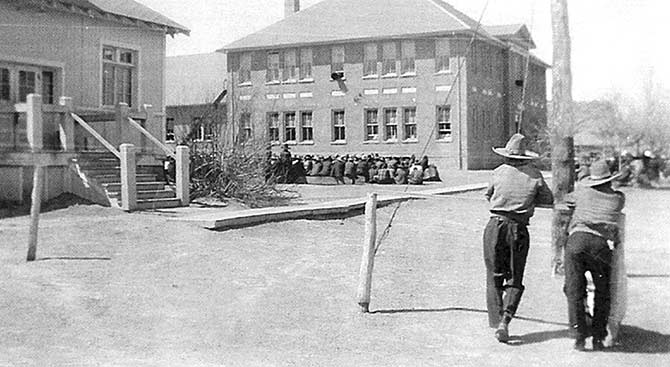
50 Years Ago: Officials discuss lack of towns on the rez

(Courtesy photo - Crownpoint Historical and Cultural Heritage Council) A meeting is held in the 1920s at the Pueblo Bonito Agency Boarding School in Crownpoint. The kindergarten building (later town hall) is on the left.
There are no towns on the Navajo Reservation, according to an editorial written by the Navajo Times’ general manager, Dick Hardwick, in March, 1968.
In fact, he said, the concept of towns is “foreign” to most residents of the reservation.
Hardwick had just come from a three-day conference sponsored by the BIA on community development and the creation of towns on the Navajo Reservation.
The conference took place years before the Kayenta Township was created and the feeling by all of the people at the conference was that it would be years, if not decades, before the first town would be established on the reservation.
A town, said Hardwick, would include a government, community center, shopping center, a park or two and certain amenities that did not exist on the reservation – regular trash pickup and snow removal when the need arises.
“Shiprock must be considered to be a government compound,” he said, along with places like Tuba City, Chinle and Window Rock.
Graham Holmes, area director for the BIA, said he did not expect to see a town established on the Navajo Reservation during the lifetime of any of the 168 people who attended the conference.
Annie Wauneka, the Council delegate from Klagetoh and Wide Ruins, was a little more optimistic, saying she expected that if the tribal government made an effort there would be a couple of towns in existence before she passed on.

(Courtesy photo – Crownpoint Historical and Cultural Heritage Council)
A meeting is held in the 1920s at the Pueblo Bonito Agency Boarding School in Crownpoint. The kindergarten building (later town hall) is on the left.
As for Hardwick, he said he hoped to be proven wrong but the creation of a town, given the current problems the tribe was facing, seemed to be an impossible task.
Speaking of Hardwick, he was apparently taken to the rejection shed this past week and given an old fashioned scolding of epic proportions.
In early March, the Times had printed an article of just a few paragraphs about the tribe getting about $140,000 for the renovation of homes belonging to veterans on the reservation.
The article gave credit to the Office of Navajo Economic Opportunity for getting the grant and indicated that ONEO would be overseeing the use of the money.
It turns out that the four-paragraph story had numerous errors in it and Hardwick would later say he was called into Navajo Tribal Chairman Raymond Nakai’s office and given a royal chewing out even though he managed to tell Nakai several times that he had nothing to do with the writing of the article.
He said it came in as a news release from a member of Congress and the paper printed it as a brief thinking that the congressman knew what he was talking about. It turned out, according to Hardwick, that the congressman did not.
The money apparently was going to a tribal program under Nakai and Nakai – not Peter MacDonald, the head of ONEO – would be overseeing it, Nakai said.
In fact, it was Nakai’s office that applied for the grant and he would have to be given the credit.
Hardwick had been general manager of the paper for four months and although he had come under criticism from some of Nakai’s staff for one thing or another, this would be the first – but not the last – time he was called on the carpet by Nakai.
Hardwick said that although he apologized several times during the meeting for the mistake and promised to correct it when the next issue came out, Nakai seemed to think that this was an effort by the paper and Hardwick to promote MacDonald, whom Nakai was hearing was planning to run against him in 1970.
Nakai told Hardwick that he would not allow the Navajo Times to try to get someone to defeat him as the paper had tried to do the previous election. If this happened again, the paper would be looking for a new editor.
Hardwick was on assignment to the tribe from the BIA and it was the BIA that was paying his salary so he had no fears of being out of a job. If Nakai removed him as editor, he would just go back to work for the BIA which was a lot less stressful.
But in the four months he had worked at the Times, Hardwick said he started enjoying the work and felt he could make a big contribution to making the paper more relevant to readers on the reservation.
So he wanted to stay on as editor but he didn’t want to get into a confrontation with Nakai because he was told by his BIA bosses before going to the paper to keep away from tribal politics.
So he set a new policy that whenever anything came in, no matter who it came from, the paper would give the chairman’s office a chance to respond.
He stressed that this did not mean the chairman’s office would be given the power to approve anything before it went into the paper, but that if the chairman’s office wanted to say something in connection with the article, the paper would consider including it.
To read the full article, pick up your copy of the Navajo Times at your nearest newsstand Thursday mornings!
Are you a digital subscriber? Read the most recent three weeks of stories by logging in to your online account.








 Highway 264,
Highway 264, I-40, WB @ Winslow
I-40, WB @ Winslow